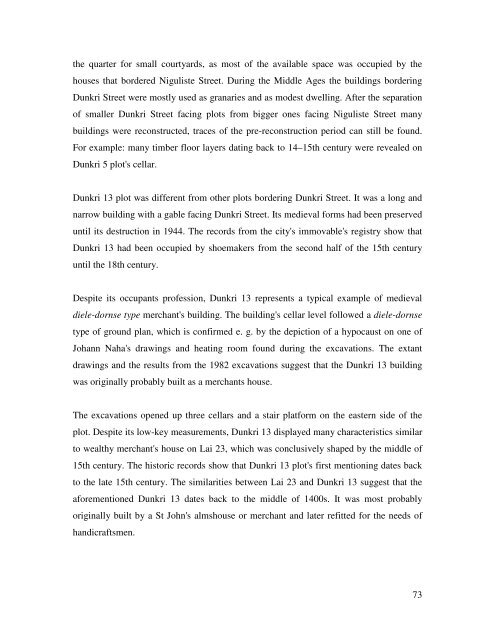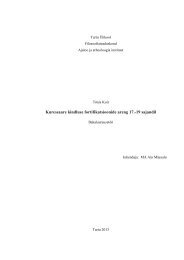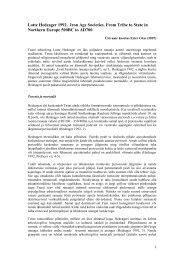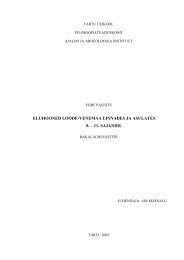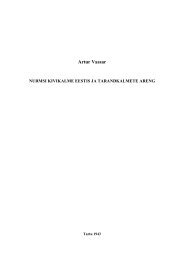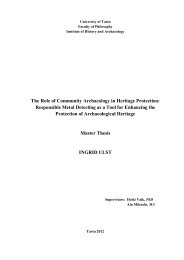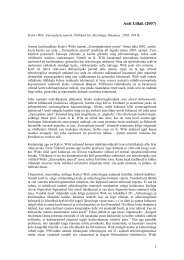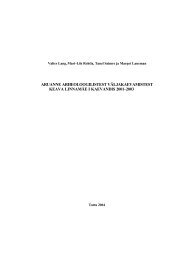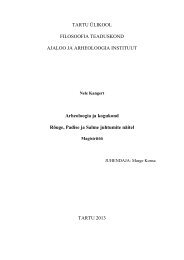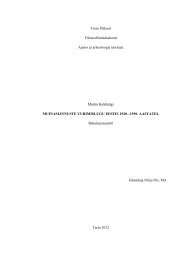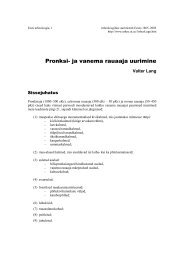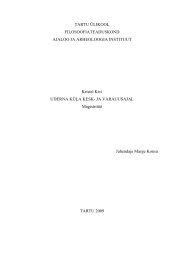TARTU ÃLIKOOL FILOSOOFIATEADUSKOND AJALOO JA ...
TARTU ÃLIKOOL FILOSOOFIATEADUSKOND AJALOO JA ...
TARTU ÃLIKOOL FILOSOOFIATEADUSKOND AJALOO JA ...
Create successful ePaper yourself
Turn your PDF publications into a flip-book with our unique Google optimized e-Paper software.
the quarter for small courtyards, as most of the available space was occupied by the<br />
houses that bordered Niguliste Street. During the Middle Ages the buildings bordering<br />
Dunkri Street were mostly used as granaries and as modest dwelling. After the separation<br />
of smaller Dunkri Street facing plots from bigger ones facing Niguliste Street many<br />
buildings were reconstructed, traces of the pre-reconstruction period can still be found.<br />
For example: many timber floor layers dating back to 14–15th century were revealed on<br />
Dunkri 5 plot's cellar.<br />
Dunkri 13 plot was different from other plots bordering Dunkri Street. It was a long and<br />
narrow building with a gable facing Dunkri Street. Its medieval forms had been preserved<br />
until its destruction in 1944. The records from the city's immovable's registry show that<br />
Dunkri 13 had been occupied by shoemakers from the second half of the 15th century<br />
until the 18th century.<br />
Despite its occupants profession, Dunkri 13 represents a typical example of medieval<br />
diele-dornse type merchant's building. The building's cellar level followed a diele-dornse<br />
type of ground plan, which is confirmed e. g. by the depiction of a hypocaust on one of<br />
Johann Naha's drawings and heating room found during the excavations. The extant<br />
drawings and the results from the 1982 excavations suggest that the Dunkri 13 building<br />
was originally probably built as a merchants house.<br />
The excavations opened up three cellars and a stair platform on the eastern side of the<br />
plot. Despite its low-key measurements, Dunkri 13 displayed many characteristics similar<br />
to wealthy merchant's house on Lai 23, which was conclusively shaped by the middle of<br />
15th century. The historic records show that Dunkri 13 plot's first mentioning dates back<br />
to the late 15th century. The similarities between Lai 23 and Dunkri 13 suggest that the<br />
aforementioned Dunkri 13 dates back to the middle of 1400s. It was most probably<br />
originally built by a St John's almshouse or merchant and later refitted for the needs of<br />
handicraftsmen.<br />
73


